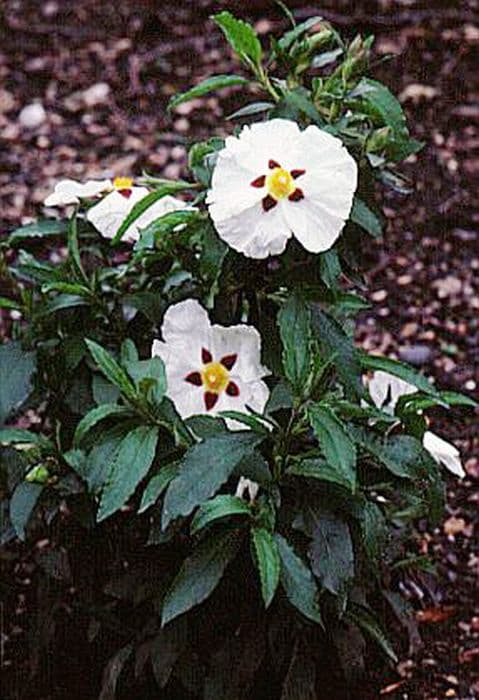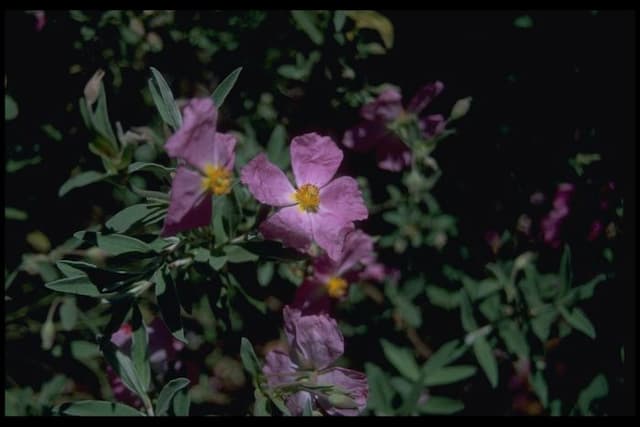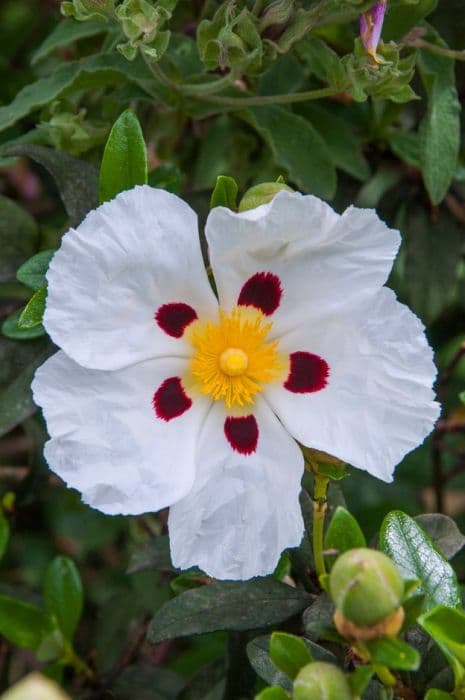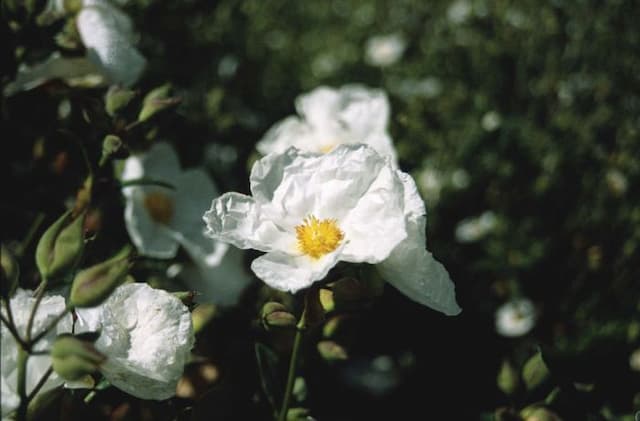Florentine Rockrose Cistus × florentinus Lam.

ABOUT
Cistus × florentinus, commonly known as the Florentine rockrose, is a hybrid plant with an attractive appearance. This species typically bears a dense foliage of evergreen leaves. The leaves are sturdy, with a slightly sticky texture and are dark green in color, exuding a lustrous sheen and often possessing a slightly wavy margin. The plant is celebrated for its abundant flowering. The flowers manifest in a beautiful display of white petals which can sometimes exhibit a faint hint of pink. These flowers typically feature a prominent yellow center, composed of a cluster of stamens that stand out starkly against the petals. The blossoms are generally large and have a papery texture, which lends a delicate air to their robust appearance. The overall form of the Florentine rockrose is rounded and bushy, with a well-branched structure that provides the plant a full and lush aspect. This added to the contrast of the dark green leaves against the bright blossoms creates an eye-catching ornamental design ideally suited to garden planting and landscape ornamentation.
About this plant
 Names
NamesFamily
Cistaceae
Synonyms
Florentine Rockrose, Florence Rockrose
Common names
Cistus florentinus (Lam.) Grosser.
 Toxicity
ToxicityTo humans
The plant Cistus × florentinus, commonly known as Rockrose, is not widely recognized as a toxic plant to humans. There is limited information on this hybrid species concerning human toxicity, and it is generally considered to be non-toxic. Therefore, there are no well-documented symptoms of poisoning from ingesting parts of this plant. Nonetheless, as with any plant, some individuals may experience allergic reactions or sensitivities, so it is advisable to exercise caution and avoid ingesting plant material unless it is known to be safe for consumption.
To pets
The Rockrose (Cistus × florentinus) is not commonly listed as a toxic plant to pets such as dogs and cats. There is little information indicating that this plant poses a significant risk of toxicity. Pets that ingest parts of the Rockrose may experience mild digestive upset, but serious symptoms of poisoning are not typically associated with this plant. However, individual pets can have different sensitivities, and it is always best to prevent pets from consuming any plants not known to be safe and to seek veterinary advice if any adverse reactions are observed.
 Characteristics
CharacteristicsLife cycle
Perennials
Foliage type
Evergreen
Color of leaves
Green
Flower color
White
Height
3 feet (0.91 meters)
Spread
5 feet (1.52 meters)
Plant type
Shrub
Hardiness zones
8
Native area
Mediterranean
Benefits
 General Benefits
General Benefits- Ornamental Appeal: Adds aesthetic value to gardens with its showy flowers and evergreen foliage.
- Drought Tolerance: Highly adaptable to dry conditions, reducing the need for frequent watering.
- Erosion Control: Can be used to stabilize soil and prevent erosion on slopes and banks.
- Wildlife Attraction: Attracts pollinators such as bees and butterflies, which are vital for the ecosystem.
- Low Maintenance: Requires minimal upkeep once established, making it a convenient choice for gardeners.
- Heat Resistance: Thrives in hot climates, making it suitable for warm and sunny gardens.
- Adaptability: Can grow in poor soils, broadening the range of planting sites.
 Medical Properties
Medical PropertiesThis plant is not used for medical purposes.
 Air-purifying Qualities
Air-purifying QualitiesThis plant is not specifically known for air purifying qualities.
 Other Uses
Other Uses- Perfumery: Rockrose (Cistus × florentinus) is a source of labdanum, a resin used in perfumes, giving them an amber-like scent.
- Aromatic Additive: The leaves and flowers can add fragrance to potpourris and scented sachets.
- Landscape Gardening: Due to its aesthetic appeal, rockrose is often used in decorative landscaping and garden design.
- Erosion Control: Rockrose plants are used in soil stabilization projects on slopes and banks due to their extensive root systems.
- Fire Barrier: The plant is sometimes used in fire-prone areas to create a fire-resistant planting zone because it is less flammable than many other Mediterranean shrubs.
- Beekeeping: Rockrose flowers are a good source of pollen and nectar for bees, improving honey production and quality.
- Insect Deterrent: The strong scent of the leaves may repel certain insects, and it is sometimes used as a natural pest deterrent in gardens.
- Eco-printing: The leaves and flowers can be boiled to make a dye for eco-printing on fabrics, giving a range of yellows, browns, and greens.
- Drought-Tolerant Planting: Rockrose is ideal for xeriscaping, a landscaping method that reduces the need for irrigation.
- Education and Conservation: It is sometimes included in educational and conservation programs to illustrate the characteristics of native Mediterranean flora.
Interesting Facts
 Feng Shui
Feng ShuiThe Rockrose is not used in Feng Shui practice.
 Zodiac Sign Compitability
Zodiac Sign CompitabilityThe Rockrose is not used in astrology practice.
 Plant Symbolism
Plant Symbolism- Resilience - Cistus × florentinus, commonly known as Rockrose, often thrives in tough conditions, symbolizing the ability to endure hardships.
- Beauty in Simplicity - Rockrose has a simple yet striking appearance, representing a beauty that is pure and without pretension.
- Healing - Historically used for its medicinal properties, the Rockrose symbolizes healing and the restoration of health.
- Protection - In some cultures, Rockrose is believed to possess protective qualities, symbolizing shielding from harm or negativity.
 Water
WaterThe Cistus 'Florentinus', commonly known as the Florentine Rockrose, requires watering that allows the soil to dry out between waterings. Generally, you should water this plant deeply every one to two weeks, providing about 1-2 gallons per plant, depending on the size and environmental conditions. During the summer, you might need to water more frequently, especially if the weather is particularly hot and dry. In contrast, reduce watering in the winter when the plant is dormant, and ensure the soil is well-drained to avoid waterlogging. It's essential to avoid overwatering to prevent root rot.
 Light
LightThe Florentine Rockrose thrives in full sunlight with at least six to eight hours of direct light each day. It's best placed in a spot where it can receive ample morning light and some protection from the intense afternoon sun in hotter climates. However, this plant is quite tolerant and can still perform well in a position with full exposure all day. Avoid deep shade, as insufficient light can impede flowering and overall vitality.
 Temperature
TemperatureThe Florentine Rockrose prefers temperate conditions and can tolerate a range from 20°F to 100°F. It's frost hardy but performs best when the temperature is between 50°F and 80°F. This plant can survive short periods of colder temperatures down to about 20°F, but prolonged exposure to temperatures below freezing may cause damage. Protection may be necessary in areas with severe winter conditions.
 Pruning
PruningPruning the Florentine Rockrose promotes a compact shape and can enhance flowering. Prune lightly after flowering has finished, usually in mid to late spring, removing any spent flowers and shaping the plant as desired. Pruning can be done annually, but avoid heavy cutting back to prevent damage to the plant. The best time for pruning is when new growth begins to appear, allowing for the removal of any dead or damaged wood and encouraging a fresh burst of growth.
 Cleaning
CleaningAs needed
 Soil
SoilRockrose (Cistus × florentinus) thrives in well-draining, gritty soil with a pH between 6.0 and 8.0. A mixture containing equal parts of loam, sand, and peat with a handful of gravel for improved drainage is ideal for this plant.
 Repotting
RepottingRockrose plants generally do not require frequent repotting and can be repotted every 2 to 3 years or when they outgrow their current pot.
 Humidity & Misting
Humidity & MistingRockrose prefers a Mediterranean climate, which means it does well in low to moderate humidity conditions typical of its native habitat.
 Suitable locations
Suitable locationsIndoor
Place in bright light, limit watering, avoid high humidity.
Outdoor
Full sun, well-drained soil, shelter from extreme cold.
Hardiness zone
8-11 USDA.
 Life cycle
Life cycleCistus × florentinus, commonly known as the Florentine rockrose, begins its lifecycle with seed germination, which is highly dependent on the right conditions of warmth and, occasionally, after exposure to fire or smoke which can simulate a natural environment after a wildfire. After germination, seedlings develop a root system and foliage as they enter the vegetative growth stage, extending stems and leaves to maximize photosynthesis. As the plant matures, it enters the reproductive stage, flowering in late spring to early summer with showy white to pink blossoms that attract pollinators. After pollination, the plant sets seed in the form of a capsule which, when ripe, opens to release seeds for dispersal. In appropriate Mediterranean-type climates, Florentine rockrose exhibits a perennial life cycle, regrowing for multiple seasons, although individual plants may have limited longevity. The plant can also spread vegetatively via branching or sometimes when lower branches come into contact with soil and take root, thus expanding its presence in a habitat.
 Propogation
PropogationPropogation time
Spring-Early Summer
Propogation: The Rockrose (Cistus × florentinus) is commonly propagated through semi-hardwood cuttings, a method that is considered both practical and popular among gardeners. This propagation is best performed in late summer when the new growth from that season has begun to harden. To do so, a gardener would cut a 4 to 6-inch (10 to 15 cm) piece of stem from the current year's growth, ensuring that at least two sets of leaves are present on the cutting. The lower leaves are then stripped, and the cut end may be dipped in rooting hormone for better success. The cutting is planted in a well-draining potting mix and kept moist until rooting occurs, which typically takes several weeks. Throughout this period, the cutting should be kept in a warm environment with indirect light to foster the growth of new roots.









